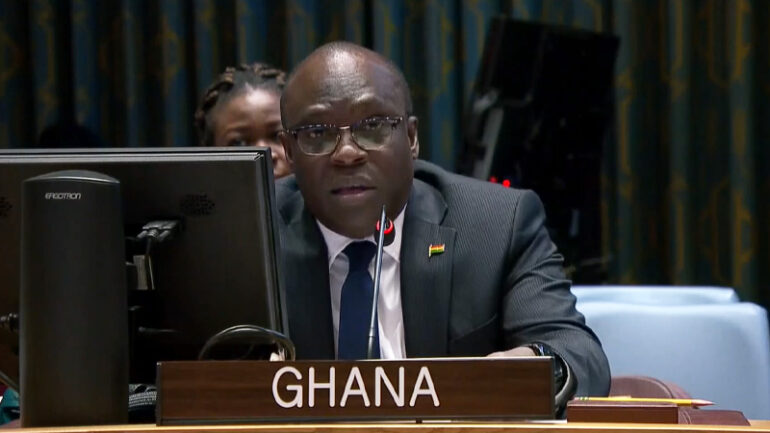UNSC Meeting on Children and armed conflict: Prevention of Grave Violations

Madam President,
I would like to begin by borrowing the words of Maya Angelou, who, in recognition of the direct implication of our actions on the lives and future of our children, stated, and I quote « Each child belongs to all of us and they will bring us a tomorrow in direct relation to the responsibility we have shown to them ».As we meet in this Chamber, therefore we should be united by a common aspiration to protect the children of our world and to ensure their wellbeing through enhanced protection measures and the pursuit of a rigorous culture of prevention.
It is in this context that Ghana welcomes Malta’s convening of this timely briefing on Children and Armed Conflict (CAAC). We share in the objective to strengthen the regime for the prevention of grave violations against children, especially in the contexts of armed conflict, and assure you, Madam President, of our utmost cooperation and commitment to the work of the Working Group on Children and Armed Conflict, which younow Chair. I would also like to thank SRSGs Virginia Gamba and Najat Maalla M’jid as well as Ms. Divina for their unique perspectives which have thrown yet another challenge to this Council regarding the need to be more proactive in preventing grave violations against children. Ghana is encouraged by the outcomes that the Office of the SRSG on Children and Armed Conflict, UNICEF, and other partners managed to achieve in 2022.
We encourage the SRSG’s continuing engagement with parties to conflict, regional organizations, civil society organisations and UN actors, which last year, led to successful outcomes including the development and implementation of relevant protocols and action plans in Burkina Faso, Nigeria, and Yemen, among others. The past outcomes inspire hope in existing capabilities to ensure child safety, even though existing needs also mean that more should be done. We remain deeply concerned by the fact that children growing up in communities ravaged by armed conflict continue to witness and experience unimaginable horrors of high proportions and frequency.
The incessant refusals by parties to conflict to lay down their arms often means that children are caught up in the line of fire and used as weapons of war. Violations such as killing and maiming, as a direct or indirect result of hostilities, including through explosive remnants of war, improvised explosive devices and the excessive use of force, among others, should not continue to rob our children of their future. The plethora of actors operating with impunity or even in power vacuums should be stopped and we must not relent in our efforts to prevent conflicts if we are to assure the full protection of children.
Madam President, we would like to share four (4) key messages on how we can strengthen prevention within the CAAC agenda.
First, we believe that the UN’s early warning and violence monitoring efforts should employ relevant child-sensitive indicators. Prevention can be truly successful if risk factors that lead to grave violations against children are identified, understood and thoroughly addressed before the eruption of a conflict, or even while a conflict is in full force. An example of a major risk area that can be focused on and addressed is the impact of socio-economic factors such as poverty and lack of educational opportunities which increases the susceptibility of children to recruitment and re-recruitment by armed groups and sexual violence among other violations. Peacekeeping missions by the United Nations and regional organisations should seek to integrate child protection obligations into mission planning, policies, decisions, and activities and must include child protection focal points in field operations.
Secondly, given the cross-border nature of some violations against children in armed conflict, there is the need for synergies between the United Nations, regional organizations and member states through the development and implementation of joint strategies and coordination mechanisms that enhances information exchange and cooperation to prevent cross border recruitments and use, as well as trafficking.
Thirdly, we urge regional organisations to deepen their collaboration with civil society organisations in the areas of early warning and early response with a tailored focus on child protection. Platforms such as the ECOWAS Peace and Security-CSO Platform, if strengthened, can help to better detect, and predict threats to peace and security in West Africa and their effects on children. For this reason, we encourage ECOWAS in its partnership with West Africa’s network of CSOs to foster the sharing of information and experiences geared towards more effective conflict prevention and child protection.
Lastly, an indication of the level of importance we attach to the Children in Armed Conflict agenda is reflected by the resources we devote in support of its implementation. We therefore urge the Council’s full support for the allocation of targeted, practical and rapid resources to facilitate responses to threats against children or avert potential dangers they may face. Moreover, there is the urgent need for targeted resources and collaborative efforts by the international community and member states to sensitise communities on explosive ordnance risks as well as to ensure the identification, fencing off and eventual destruction of all manner of explosive ordnances, which could endanger the lives of children. We also urge continuing support for schools as hubs of peace, including through sustained support for school feeding programmes.
In concluding, I would like to reiterate that while significant strides have been made globally in raising awareness and preventing grave violations against children in armed conflict, the miles left to travel is longer. Ghana is committed to travelling the extra mile for the cause of protecting these children and securing their safe and sustainable future.
I thank you
